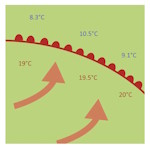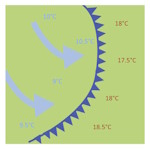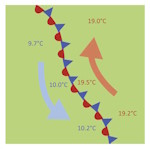Weather Fronts
Types of Front
There are four types of fronts normally recognised in weather forecasting. They are the warm, cold, stationary and occluded fronts, each of which has a different influence on the local weather.
The descriptions given below are not scientifically absolutely accurate but are helpful in understanding how they influence our weather. If you wish to see a more accurate description of frontal systems take a look at the Wikipedia entry and you can find out all about frontoge1nesis which includes horizontal deformation, horizontal shearing, vertical deformation, differential vertical motion, latent heat release, surface friction, turbulence and mixing, and radiation. I'd stick to the simple version for now!
There are four types of weather fronts, cold, warm, stationary, and occluded. Cold fronts are associated with cumulus cloud formation and thunderstorms. Warm fronts are associated with gray skies and drizzle. Occluded fronts result in both warm front and cold front type weather on either side of the front.
The four fronts are illustrated on synoptic charts (forecast charts) in the following way. The semi circles and triangles show the direction of travel of the front.
Warm Fronts

A warm front forms when a warm air mass pushes into a cooler air mass, shown in the image to the right (A). Warm fronts often bring stormy weather as the warm air mass at the surface rises above the cool air mass, making clouds and storms. Warm fronts move more slowly than cold fronts because it is more difficult for the warm air to push the cold, dense air across the Earth's surface. Warm fronts often form on the east side of low-pressure systems where warmer air from the south is pushed north.
You will often see high clouds like cirrus, cirrostratus, and middle clouds like altostratus ahead of a warm front. These clouds form in the warm air that is high above the cool air. As the front passes over an area, the clouds become lower, and rain is likely. There can be thunderstorms around the warm front if the air is unstable.
On weather maps, the surface location of a warm front is represented by a solid red line with red, filled-in semicircles along it, like in the map on the right (B). The semicircles indicate the direction that the front is moving. They are on the side of the line where the front is moving. Notice on the map that temperatures at ground level are cooler in front of the front than behind it
Cold Fronts
 A cold front forms when a cold air mass pushes into a warmer air mass. Cold fronts can produce dramatic changes in the weather. They move fast, up to twice as fast as a warm front. As a cold front moves into an area, the heavier (more dense) cool air pushes under the lighter (less dense) warm air, causing it to rise up into the troposphere. Lifted warm air ahead of the front produces cumulus or cumulonimbus clouds and thunderstorms.
A cold front forms when a cold air mass pushes into a warmer air mass. Cold fronts can produce dramatic changes in the weather. They move fast, up to twice as fast as a warm front. As a cold front moves into an area, the heavier (more dense) cool air pushes under the lighter (less dense) warm air, causing it to rise up into the troposphere. Lifted warm air ahead of the front produces cumulus or cumulonimbus clouds and thunderstorms.As the cold front passes, winds become gusty. There is a sudden drop in temperature, and also heavy rain, sometimes with hail, thunder, and lightning. Atmospheric pressure changes from falling to rising at the front. After a cold front moves through your area, you may notice that the temperature is cooler, the rain has stopped, and the cumulus clouds are replaced by stratus and stratocumulus clouds or clear skies.
On weather maps, a cold front is represented by a solid blue line with filled-in triangles along it, like in the map. The triangles are like arrowheads pointing in the direction that the front is moving. Notice on the map that temperatures at the ground level change from warm to cold as you cross the front line.
Occluded Fronts
 Sometimes a cold front follows right behind a warm front. A warm air mass pushes into a colder air mass (the warm front), and then another cold air mass pushes into the warm air mass (the cold front). Because cold fronts move faster, the cold front is likely to overtake the warm front. This is known as an occluded front.
Sometimes a cold front follows right behind a warm front. A warm air mass pushes into a colder air mass (the warm front), and then another cold air mass pushes into the warm air mass (the cold front). Because cold fronts move faster, the cold front is likely to overtake the warm front. This is known as an occluded front.At an occluded front, the cold air mass from the cold front meets the cool air that was ahead of the warm front. The warm air rises as these air masses come together. Occluded fronts usually form around areas of low atmospheric pressure.
There is often precipitation along an occluded front from cumulonimbus or nimbostratus clouds. Wind changes direction as the front passes and the temperature either warms or cools. After the front passes, the sky is usually clearer, and the air is drier.
On a weather map, shown to the right, an occluded front looks like a purple line with alternating triangles and semicircles pointing in the direction that the front is moving. It ends at a low pressure area shown with a large ‘L’ on the map, begins at the other end when cold and warm fronts connect.
Stationary Fronts
 A stationary front forms when a cold front or warm front stops moving. This happens when two masses of air are pushing against each other, but neither is powerful enough to move the other. Winds blowing parallel to the front instead of perpendicular can help it stay in place.
A stationary front forms when a cold front or warm front stops moving. This happens when two masses of air are pushing against each other, but neither is powerful enough to move the other. Winds blowing parallel to the front instead of perpendicular can help it stay in place.A stationary front may stay put for days. If the wind direction changes, the front will start moving again, becoming either a cold or warm front. Or the front may break apart.
Because a stationary front marks the boundary between two air masses, there are often differences in air temperature and wind on opposite sides of it. The weather is often cloudy along a stationary front, and rain or snow often falls, especially if the front is in an area of low atmospheric pressure.
On a weather map, a stationary front is shown as alternating red semicircles and blue triangles. Notice how the blue triangles point in one direction, and the red semicircles point in the opposite direction.
The data on this site is for information only as accuracy cannot be guaranteed.
It is not to be used where life or limb may be compromised.
Weather Warnings
It is not to be used where life or limb may be compromised.
Weather Warnings